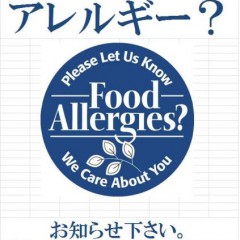亀清旅館は伝統的な日本の温泉旅館でありながら、せっかくこの青い目の若旦那がいるからアメリカなりの「おもてなし」を少し取り入れようてしております。その1つはお茶菓子に手作りのクッキーを出しています。私の母親のレシピーで、シアトルの味です。そして、長野県はせっかく、日本のそばの国だから、クッキーを焼く時に小麦粉の4分の1はそば粉にしています。和洋折中と言うか、両方の良い所を生かすとの目的。
先日に泊まったお客さんはお帰りの時に「夕べのお茶菓子にそば粉が入っていただろう」と。アレルギーの現象(熱、吐きそうになった)が出たらしいです。「そば粉を入れると必ず言わないと駄目。普通、クッキーに入っていると思わない」と怒られました。
そばの国の長野にクッキーにそば粉が入っていてもおかしいかどうかは別として、普段はアレルギーに関してはどちらの責任になるでしょうか?アレルギーを持っている方が言うべき?アレルゲンを入れた方が表示すべき?
ある宿は問題が発生するたびに注意書きを張る。結局、宿が注意書きだらけになっちゃう。お客さんのご健康はもちろん大事にしたい(だからこそ皆様がRelax出来るこの温泉宿を経営している!)けど、注意書きだらけにしたくない。切りがないし。
クッキーも、手作りだからこそ、包みはしない。お店で買うお菓子でも、アレルゲンが書いてあるに限られていない。
じゃ、お客さん一人一人に入っているアレルゲン1つ1つを言う?少人数のお客様に可能としても団体には無理です。
色々と調査したら、ハワイ大学のこのデザインを見当たりました。日本語を足して、サインを作ってみました。団体の皆様でも必ず通るフロントに置いてみています。これでアレルギーの問題が2度と出ないようにしたいと思います。
While our inn, Kamesei Ryokan is a traditional onsen ryokan, as the proprietor (myself) is an American, we try to incorporate some touches of American-style hospitality. One of those touches is to serve home-made cookies as the tea sweets for the tea we provide in the guest rooms upon arrival. Nagano Prefecture is famous for its soba buckwheat noodles, as it is one of the main growing regions for buckwheat in Japan. In an effort to combine the best of both worlds, I substitute 1/4 buckwheat flour for regular wheat flour when I bake the cookies.
When guests make reservations including meals, we always ask about any food allergies. However, the other night we had some guests who requested accommodation only, and no allergies were mentioned. The next morning at checkout, the gentleman accosted me, "There was soba in those cookies, right?" Apparently he had an allergic reaction (fever and nausea). He was so upset. "Every year, thousands of people die from soba allergy. You have to tell each person there is soba in those cookies!"
On one hand, we obviously don't want to kill our guests. On the other, I was upset that our positive efforts were being villified. If the man's life was at stake due to his soba allergy, wouldn't it behoove him to ask about it first? He claimed the onus was ours, as people normally don't expect soba flour in cookies. I say there is nothing unusual about it here in Nagano, Japan's soba prefecture.
Practically speaking, it is not possible to ask each and every individual guest about their allergies, soba or otherwise, as some guests come in groups and our main contact is with the group's organizer, not the individuals. However, all the guests pass by the front desk on the way to the rooms, hence a "Food Allergies?" sign on the front desk strikes me as being the most effective.
I found this design on the University of Hawaii website, and Professor Saulo there graciously granted us permission to use it. We'll give it a try and see what kind of response the sign receives.
As a side note, another inn that I am familiar with approaches problems like this by putting up warning notices. "Don't do this" or "Avoid doing that", etc. The problem is, the interior of the inn ends up getting plastered in warning signs. With our home-made cookies, the charm is that they are not some pre-wrapped, mass-produced sweet. If they were, there would no doubt be a warning label that soba, nuts, chocolate and other allergens are included. While there is a need for warning the guests, it would go against the home-made charm to plaster them with signs.
This "Food Allergies?" sign seems to strike the right balance between the need to advise the guests and our desire to avoid tacky warning signs all over the place. Time will tell if it works! Will keep you posted.




